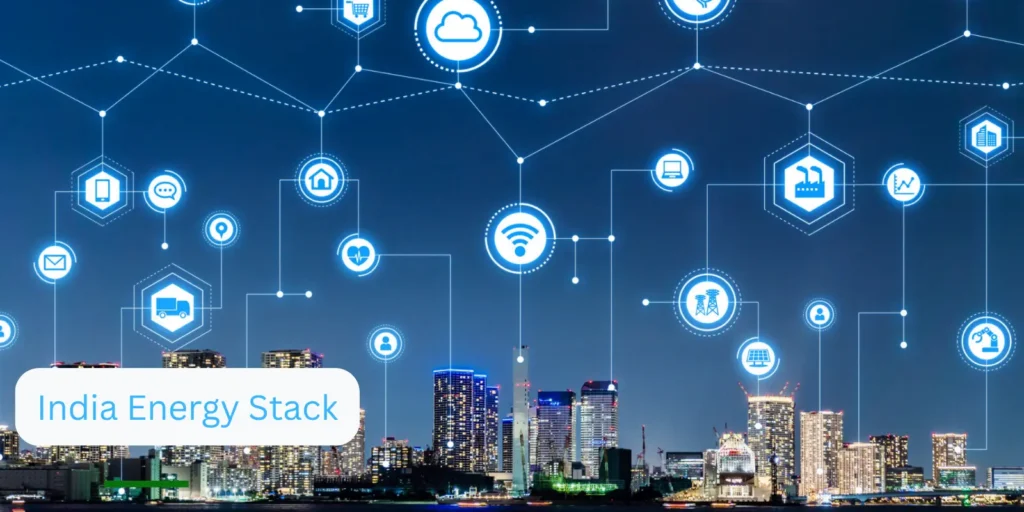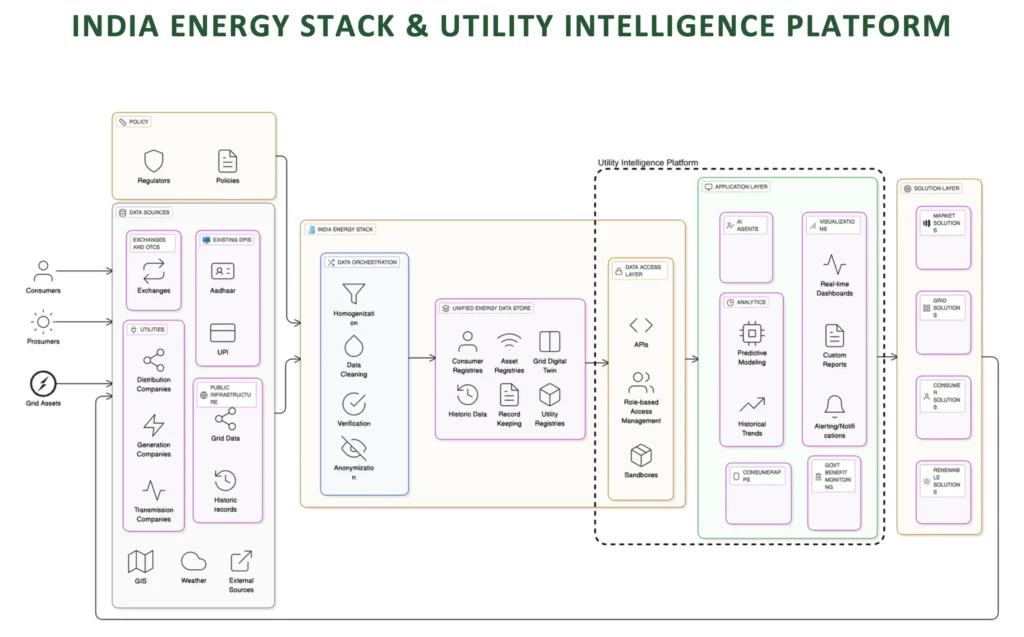
On 28th June 2025, the Ministry of Power, Government of India announced the launch of a task force to conceive the India Energy Stack (IES), a unified digital infrastructure designed to catalyze India’s transition to a sustainable, efficient, and intelligent energy ecosystem.
The India Energy Stack builds upon the Smart Grid Observatory (SGO), which was started in 2023 under the India–EU Clean Energy and Climate Partnership (EU-CECP) and is now being spearheaded by the Ministry of Power.
Background
India’s energy sector is undergoing rapid transformation to meet the demands of economic growth, rising renewable energy integration, and its Net Zero commitments by 2070. However, fragmented digital systems, poor interoperability, and the absence of unique identifiers for assets, consumers, and transactions impede efficient grid management and innovation.
Unlike financial infrastructures (e.g., NPCI’s UPI), the energy sector lacks standardised platforms for seamless integration and cross-DISCOM transactions. Existing digital solutions like Scada, Smart Meters etc have not been developed with interoperability as part of the design and have limited scalability.
Further, Integrated systems typically lack cross-regional communication and Demand-side management possibilities are limited despite the availability of machine readable data.
These challenges collectively point to a fundamental need for a unified digital architecture that can serve as the backbone for India’s energy transformation. The solution lies in adopting a Digital Public Infrastructure (DPI) approach, which has proven successful in other sectors of the Indian digital economy.
What is the India Energy Stack?
Inspired by the success of India’s Digital Public Infrastructure (DPI) like Aadhaar, UPI, and DigiLocker, the Energy Stack aims to create a modular, open, and interoperable digital framework that can accelerate innovation and stakeholder collaboration across the energy sector. The India Energy Stack is a layered digital architecture built to enable:
- Seamless Data Exchange between consumers, utilities, grid operators, EV players, and energy service providers.
- Decentralized Energy Management including rooftop solar, EV charging, battery storage, and smart metering.
- Market Access for All – democratizing energy trading, retailing, and billing.
- Innovation Enablement through APIs and public data registries that startups and developers can leverage.
The Ministry of Power is reimagining the digital backbone for India’s Power sector by creating a Digital Public Infrastructure (DPI) for the Power sector through an India Energy Stack (IES). Essentially the IES will offer
- Unique IDs for consumers, assets, and transactions
- Open APIs for seamless system integration
- Real-time, consent-based data sharing
- Plug & Play Tools for consumer empowerment, market access, and innovation
Layers of India Energy Stack
The India Energy Stack will operate through 3 Core layers:
- The Base Data layer includes Registries, identifiers, and secure data flows.
- The Services layer includes Open APIs, consent architecture, and interoperability protocols.
- The Applications layer includes Platforms like UIP for real-time analytics, simulations, and consumer-facing apps.

Aadhar Vs IES
Prior to Aadhaar, digital identities were fragmented and catering to specific functions (driving, paying taxes etc). As a foundational identity system, Aadhaar established a standardised, verifiable, and interoperable identity infrastructure paving the way for seamlessly verifying identity and address.
Aadhaar facilitated interoperability through its Proof of Identity (PoI) and Proof of Address (PoA) APIs thereby supporting scalable platforms like DigiLocker, FASTag, DigiYatra, and UPI through standardised digital infrastructure.
Similarly India Energy Stack will enable standardised APIs for seamless integration, cross-state energy transactions, and innovation through open platforms. IES can enable energy fintech, virtual power plants, and peer-to-peer trading that cannot exist without a standardised, interoperable digital infrastructure.
What’s Next
Task Force: The Ministry of Power has constituted a dedicated Task Force comprising experts, which will steer the development of the India Energy Stack. The task force is chaired by Dr. Ram Sewak Sharma, with Nandan Nilekani as Chief Mentor.
Proof to Concept: The Ministry will undertake a 12-month Proof of Concept (PoC) to demonstrate IES through real-world use cases in partnership with selected utilities. This includes piloting the Utility Intelligence Platform (UIP), a modular, analytics-driven application built on IES to support utilities, policymakers, and consumers with real-time insights and smarter energy management. Pilot testing for this platform will be carried out with DISCOMs in Mumbai, Gujarat, and Delhi.
Following the PoC, a national rollout blueprint and capacity-building program will be launched to scale the stack across India.
YoCharge X IES
As the India Energy Stack takes shape, YoCharge is positioned as a foundational digital layer — empowering CPOs, enabling eMSPs, integrating with DISCOMs, and unlocking access to clean, affordable energy for millions of EV users.
With the Energy Stack, India is not just digitizing energy — it is reimagining its future. At YoCharge, we’re honored to contribute to this transformation. As an active stakeholder in building this stack, we believe the future of energy is:
- ⚡ Electric
- 🔗 Connected
- 🧠 Intelligent
- 🫱🏽🫲🏾 Open for all
The future of Energy is both Digital & Green. Join us in building it.